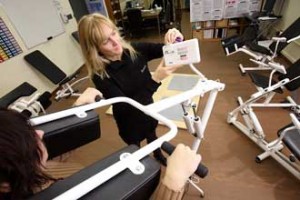
New program aims to boost physical and emotional health of breast cancer survivors
By Pascal Zamprelli
Even once treatment has concluded and the disease subsided, victims of cancer continue to struggle, physically and emotionally. Research suggests that simple physical activity can lessen or even reverse the damage to both body and mind, increasing survival rates.
This appears to be especially true if exercise is undertaken immediately after treatment, precisely when those who could benefit most are least likely to visit the gym.
Recently, McGill and fitness giant Curves have teamed up to tackle the problem: inactive women diagnosed and treated for breast cancer at the Cedars Breast Clinic of the McGill University Health Centre will be offered a free membership to Curves. The program will reach about 200 women. But the program doesn’t end with the membership. The progress of the patients will be closely monitored by Dr. Catherine Sabiston, a professor of Exercise Psychology in the Faculty of Education and Director of the Health Behavior and Emotion Lab, who will assess changes in the women’s physical health (fitness, strength, weight) as well as in their psychosocial health (stress levels, social support systems, quality of life).
It represents a chance for the women to regain both muscle and confidence, and for Sabiston to delve deeper into questions about which she is passionate.
Though her UBC doctoral work focused on physical activity in adolescents, Sabiston found time for extra research on the side. She teamed up with a medical doctor who was helping breast cancer survivors regain their physical strength by joining a dragon boat team. While his interest was in the physiological mechanisms at play during exercise, she felt there was another aspect worth exploring.
“I wanted to learn more about what the women were getting from dragon-boating on a personal level,” she says. “I was more interested in the psychosocial elements: What are they getting from a social support perspective? How do they feel about their physical self and their body image? Are they gaining in terms of psychological growth and emotional well-being?”
Upon arriving at McGill in 2007, Sabiston obtained a grant to develop physical activity initiatives for breast cancer survivors. Importantly, she wanted to study the effects of that exercise from the moment treatments ended (unlike the dragon-boaters, who had been out of treatment for at least six months).
“So my research focuses on better understanding their immediate physical activity struggles, barriers, and benefits, over that year and half [right after treatment],’ she says, “the most ideal time to target these
women.”
She soon contacted Dr. Sarkis Meterissian, Director of the Cedars Clinic, who was already working on wellness initiatives for breast cancer survivors, and had been in touch with Curves. Sabiston explained the physical activity component of her research, and they knew they were on to something good.
They identified the ideal candidates, currently being targeted for the program: women who had been inactive for most of their lives, or who had become inactive before being diagnosed, who were still inactive, and who had just completed their treatment. “Even if they don’t follow the complete Curves plan,” says Sabiston, “they’re at least going to exercise and try to make a routine out of it. At the beginning, that’s essential.”
Curves will send updates on participants’ progress in terms of weight and strength, to complement assessments made during regular check-ups at the clinic.
But on the psychosocial side, participants will be asked to fill out a series of surveys “based on reliable instruments to assess things like social support, psychological well-being, and body-image,” says Sabiston. “We’re looking at how the exercise circuit helps breast cancer survivors enhance all dimensions of quality of life.”
Therein lay the benefits she expects to see, based on her previous research, such as “psychological growth” – the notion that having had breast cancer allows women to “grow and feel empowered out of their experience, so that they can try new things, meet new people, and gain a new sense of personal strength.”
Sabiston believes the program will enhance crucial social support networks, a need patients often express. “They don’t need any more help in terms of breast cancer,” says Sabiston, “what they need is that support around exercise, health, and well-being.”
